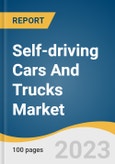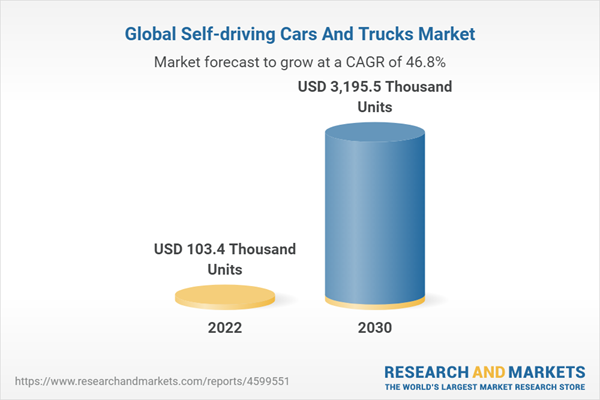The global self-driving cars and trucks market demand is anticipated to reach 3, 195.5 thousand units by 2030, it is expected to grow at a compound annual growth rate (CAGR) of 46.8% from 2023 to 2030. A self-driving vehicle combines various sensors and networking systems that assist the computer in driving the vehicle. Thus, several technology providers such as Google Inc. and Tesla Motors have also entered the market and contributed to the research and development of self-driving vehicles.
For instance, In March 2023, Google LLC, a U.S.-based technology company, collaborated with Mercedes-Benz, a luxury vehicle company in Germany, to develop a customized navigation interface. This collaboration aims to use Google's AI and data functionalities to help Mercedes-Benz accelerate its sustainability efforts, advance autonomous driving, and improve the customer experience.
The automobile industry is dynamic and changes with technological advancements. Several major players, such as General Motors Company, Volkswagen AG, Mercedes-Benz, and Bayerische Motoren Werke AG (BMW), invest a significant part of their revenue in the R&D of technologies. Currently, there is a growing trend of self-driving vehicles in the automotive industry, thus attracting larger investments in the development of these vehicles.
For instance, In February 2020, Pony.ai, an autonomous vehicle technology company in the U.S., raised around $400 million, led by an investment by Toyota Motor Corporation, an automotive manufacturer in Japan, to strengthen and extend the two companies' partnership in mobility services. This initiative aims to improve Pony.ai's autonomous driving system's integration with Toyota's robust vehicle platforms and technologies.
The self-driving cars and trucks industry has been segmented based on transportation and defense applications. Furthermore, the transportation segment has been bifurcated into industrial and commercial applications. The transportation segment is expected to have a higher market share; however. The defense segment is expected to portray the highest growth over the forecast period.
The defense sector witnessed a growth in demand for autonomous vehicles. Moreover, it is expected to be one of the most prominent applications during the forecast period due to various initiatives. For instance, in September 2022, Autonomous vehicles are currently being tested by the Defense Advanced Research Projects Agency (DARPA), U.S. Department of Defense, to generate autonomous vehicles that can function as traditional combat vehicles that the American military can utilize.
North America accounted for the largest market share in 2022. The demand for self-driving vehicles is expected to increase over the forecast period in line with rising government regulations and increased acceptance of self-driving vehicles in the U.S. Government amendments to traffic regulations to support autonomous mobility on public roads are the primary factor accelerating the region's growth. For instance, the National Highway Traffic Safety Administration (NHTSA), a traffic regulation institute in the U.S., approved testing for self-driving vehicles in several states, including California, Nevada, Michigan, Florida, and Washington, D.C.
For instance, In March 2023, Google LLC, a U.S.-based technology company, collaborated with Mercedes-Benz, a luxury vehicle company in Germany, to develop a customized navigation interface. This collaboration aims to use Google's AI and data functionalities to help Mercedes-Benz accelerate its sustainability efforts, advance autonomous driving, and improve the customer experience.
The automobile industry is dynamic and changes with technological advancements. Several major players, such as General Motors Company, Volkswagen AG, Mercedes-Benz, and Bayerische Motoren Werke AG (BMW), invest a significant part of their revenue in the R&D of technologies. Currently, there is a growing trend of self-driving vehicles in the automotive industry, thus attracting larger investments in the development of these vehicles.
For instance, In February 2020, Pony.ai, an autonomous vehicle technology company in the U.S., raised around $400 million, led by an investment by Toyota Motor Corporation, an automotive manufacturer in Japan, to strengthen and extend the two companies' partnership in mobility services. This initiative aims to improve Pony.ai's autonomous driving system's integration with Toyota's robust vehicle platforms and technologies.
The self-driving cars and trucks industry has been segmented based on transportation and defense applications. Furthermore, the transportation segment has been bifurcated into industrial and commercial applications. The transportation segment is expected to have a higher market share; however. The defense segment is expected to portray the highest growth over the forecast period.
The defense sector witnessed a growth in demand for autonomous vehicles. Moreover, it is expected to be one of the most prominent applications during the forecast period due to various initiatives. For instance, in September 2022, Autonomous vehicles are currently being tested by the Defense Advanced Research Projects Agency (DARPA), U.S. Department of Defense, to generate autonomous vehicles that can function as traditional combat vehicles that the American military can utilize.
North America accounted for the largest market share in 2022. The demand for self-driving vehicles is expected to increase over the forecast period in line with rising government regulations and increased acceptance of self-driving vehicles in the U.S. Government amendments to traffic regulations to support autonomous mobility on public roads are the primary factor accelerating the region's growth. For instance, the National Highway Traffic Safety Administration (NHTSA), a traffic regulation institute in the U.S., approved testing for self-driving vehicles in several states, including California, Nevada, Michigan, Florida, and Washington, D.C.
Self-driving Cars And Trucks Market Report Highlights
- The demand for self-driving cars and trucks is expected to grow owing to the rising number of regulations laid down by the governments of various developed and developing nations
- The transportation sub-segment is expected to grow at the highest CAGR of 43.8% over the forecast period. The growing popularity of electric and hybrid vehicles with various degrees of automation has significantly increased the demand for autonomous vehicles in the transportation segment
- The U.S., Chinese, and Japanese markets are expected to witness significant growth over the forecast period owing to the large-scale testing and adoption of self-driving cars and trucks in the transportation sector
- Audi AG, BMW AG, Daimler AG (Mercedes Benz), Ford Motor Company, General Motors, Google LLC, Honda Motor Corporation, Nissan Motor Company, Tesla, Inc, Toyota Motor Corporation, Uber Technologies, Inc, Volvo Car Corporation, and Volkswagen AGare some of the key incumbents of the self-driving cars and trucks industry
Table of Contents
Chapter 1 Methodology and Scope
Chapter 2 Executive Summary
Chapter 3 Self-driving Cars and Trucks Market Variables, Trends & Scope
Chapter 4 Self-driving Cars and Trucks Market: Application Outlook
Chapter 5 Self-driving Cars and Trucks Market: Regional Outlook
Chapter 6 Competitive Landscape
List of Tables
List of Figures
Companies Mentioned
- Audi AG
- BMW AG
- Daimler AG
- Ford Motor Company
- General Motors Company
- Google LLC
- Honda Motor Co., Ltd.)
- Nissan Motor Company
- Tesla
- Toyota Motor Corporation.
- Uber Technologies, Inc.
- Volvo Car Corporation
- Volkswagen AG
Methodology

LOADING...
Table Information
| Report Attribute | Details |
|---|---|
| No. of Pages | 100 |
| Published | April 2023 |
| Forecast Period | 2022 - 2030 |
| Estimated Market Value ( USD | $ 103.4 Thousand Units |
| Forecasted Market Value ( USD | $ 3195.5 Thousand Units |
| Compound Annual Growth Rate | 46.8% |
| Regions Covered | Global |
| No. of Companies Mentioned | 13 |









